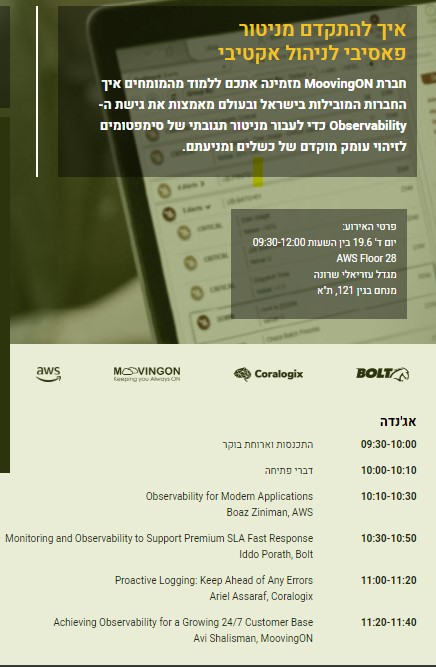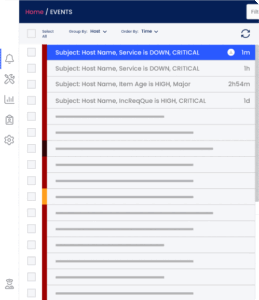In a recent Meetup event, DevOps professionals, operations professionals, and various executives gathered together at MoovingOn’s “Achieving Observability Meet Up” hosted on the 28th floor at AWS in Tel Aviv.

The venue was buzzing with lectures, panel discussions, and workshops all surrounding the idea of Observability Systems. Speakers representing AWS, Coralogix, BOLT, and MoovingOn shared exciting knowledge as to the shift the development world is taking from monitoring to observability.
Where monitoring takes a more reactive approach, alerting developers to bugs or serious problems as (or after) they occur, observability boasts a proactive approach, offering insights and the ability to predict when something is going to occur via input and output activity.
Even Apps Are Entering a New Age
With today’s technological advancements, where developers and DevOps experts are expected to deal with a much larger workload, app monitoring is shifting to an observability approach implemented to increase efficiency.
With monitoring systems expected to aggregate so much more data at a higher frequency, the chances for error or issues to fall through the cracks automatically increase. In addition, more application components have become available, leaving developers and IT Ops overwhelmed with the number of metrics and alerts they have to monitor, making the “big picture” very difficult to see. Observability aggregates all of these dashboards, components, and data into one place, allowing developers to gain a holistic understanding of the relevant alerts as well as a big picture of the system’s health.
The More “Open” Approach
There is a common trend where one specific expert knows how to work their specific domain, which makes it difficult for interconnected repair, not to mention communication. As application components and tools increase in availability, there is a rising need for more participation from developers.
Moreover, the implementation of microservices further distances and separates the various components, turning one all-encompassing picture into puzzle pieces that don’t always connect with each other. This prevents issues from being solved quickly, possibly harming user experience and costing an organization large sums to fix problems.
Observability is more effective as its open approach offers full transparency to all operations teams and developers of any domain, allowing access and tools in a user-friendly manner, instantly increasing the number of eyes and hands available to solve bugs and issues.
Keep Up with the Times
Taking into consideration the constantly evolving digital landscape, releases and updates are expected to occur far more frequently than before. At times, certain services or components might change or might not be available due to regional regulation, and this is where adaptability is at high demand.
At the meet up event, many discussions recalled the release of an update with no proper contextual data aggregated. Changes are often made without an accurate understanding of the issues, wasting precious time and resources without necessarily improving the problem that was experienced firsthand.
Observability allows IT Ops to make the best-informed decision as it provides a look into not only to the big picture, but it possesses the capability to dive deep into the issue and locate it directly. Additionally, observability tell the story behind a system disruption, as it is possible to trace it back and see what happened along the way, ensuring the updated version takes care of the problem at its source rather than just where it was identified (which may not always be the same thing).
The Clearer Picture
The monitoring approach requires keeping track of many logs, tickets, and alerts, which has proven to be not only difficult, but also inefficient to manually monitor and process the data aggregated from all ports. Many times, alerts and tickets fill up inboxes, a rule is decided around it, and most parties continue to tackle the hundreds of others awaiting their attention.
Logs are diverse and can be difficult to understand when observing them separately, especially if the log does not necessarily pertain to the service relevant to the specific developer. This leaves out a lot of necessary data when considering insights and wanting to improve service.
Observability systems are built on 4 main pillars: application and infrastructure monitoring, visualization, alerts correlation and log analytics. A successful system will provide an added layer to monitoring where IT Ops can access a consolidated, “big picture” of an application and production issues through aggregating and displaying logs, analytics, alerts, and traces in one place, enabling them to fix issues, understand the problems where they lie, and improve services overall.
Observability Systems
A strong observability system is proactive, predicts issues before they occur, reduces friction to identify and solve production issues, and increases the velocity of processes, releases, and the ability to update and track changes. The system should be able to select and present only relevant data to the issue being observed, along with providing the option to trace and identify the route of the problem as well as requests from one service to another.
By reducing the implementation of code changes, simplifying complexities and management and automating operations, an organization is able to maximize their apps’ efficiency, architecture, operations, and software development.
Where We Are Now
MoovingOn’s “Achieving Observability Meet Up” provided expert insights into the growing notion of observability systems and how they drastically improve app development and releases, making them more accurate and easier to manage.
Where monitoring looks to answer “What’s the problem and why is it happening?”, observability asks “Is everything working properly?”, offering specific information as to the source of anything that produces a “no” to that question.
The topic of observability has earned a proper seat at the table for development teams and the discussions on June 19th not only observed the challenges of the current state of affairs, but also focused into the current and future solutions that have been adapted to fit today’s more advanced technical environments.
For your convenience, the slides from the Meetup can be viewed here.
For a deeper look into MoovingOn’s production management platform and how it maximizes observability for your IT Ops teams, click here.


